- Submissions

Full Text
Evolutions in Mechanical Engineering
Developments in Dense Geomagnetic Array Observation Technology
Xiaoyu Shen1* and Yujia Cao2
1Suzhou Vocational Institute of Industrial Technology, China
2Institute of Geophysics, China Earthquake Administration, China
*Corresponding author:Xiaoyu Shen, Suzhou Vocational Institute of Industrial Technology, China
Submission: November 15, 2023;Published: November 28, 2023

ISSN 2640-9690 Volume5 Issue1
Abstract
As an important geophysical fundamental field, the geomagnetic field is widely used in the fields of geoscientific research, mineral exploration, space weather monitoring, earthquake monitoring and forecasting. More and more geomagnetic earthquake precursor anomaly information has been found in the study of seismomagnetic relationship. However, the reliability of anomaly information is often limited by the number of observation points. In view of the high construction cost, large land acquisition area and construction difficulties of the existing traditional geomagnetic station observation mode, which restricts the construction of high-density geomagnetic measurement points, the development of low-cost buried dense geomagnetic observation platform array is very necessary. To scientifically design the dense geomagnetic observatory array and seek the optimal solution of construction cost and observation data quality, this paper elaborates on the status and development trend of geomagnetic array observation technology from the perspective of array observation mode and measurement point observation technology. In this paper, the development status and shortcomings of the continuous observation mode of fixed measurement points, the periodic re-measurement mode of fixed measurement points, as well as the development status and shortcomings of the strict magnetic house-type measurement point observation technology and the simple buried measurement point observation technology are summarized in detail, to provide reference for the design of the dense geomagnetic observation station array.
Keywords:Dense geomagnetic array; Array observation mode; Observation technology
Introduction
The geomagnetic field is a fundamental geophysical field on a global scale. Its research results are widely used in the fields of geoscience research, mineral exploration, space weather monitoring, military navigation, earthquake monitoring, etc. [1]. In earthquake monitoring, with the in-depth study of the seismomagnetic relationship, researchers have found that the geomagnetic field will change abnormally during the process of earthquake conception and occurrence [2,3]. For the seismomagnetic anomaly information, scholars have conducted research from various angles. More and more geomagnetic seismic precursor anomalies have been discovered, but the reliability of the anomalies is often limited by the number of observation points. The analysis of seismomagnetic anomalies is usually based on the observation data of only one station near the epicenter and the reliability of the anomalies is questionable if the interference data cannot be excluded. Since mainland China is in the mid-latitude region, the exogenous field that causes short-period variations in the geomagnetic field is approximately homogeneous over a large area of the ground [4]. Therefore, if there are multiple geomagnetic measurement points near the epicenter and the points monitor pre-seismic anomalous signals with varying amplitudes, it will significantly increase the credibility of the anomalous signals. In addition, due to the limited distance from the epicenter range of the pre-seismic geomagnetic anomaly signals extracted by polarization methods and other methods, there is a 90% possibility of detecting the pre-seismic ULF wave anomaly signals only when the relationship between the epicenter distance R and the magnitude M satisfies 0.025R≤M-4 [5,6]. Therefore, only densely deployed geomagnetic stations can effectively meet the requirement of having multiple stations in the range of epicenter distance. At the same time, the encrypted observation of the geomagnetic field in key seismic monitoring areas currently relies mainly on mobile geomagnetic measurements. Meanwhile the geomagnetic field is remeasured four times per year, and most of them only observe the total field strength of the geomagnetic field. The inability to obtain information on changing magnetic field anomalies in a timely manner affects the timeliness of obtaining information on seismic and magnetic anomalies (Figure 1).
Figure 1:Geomagnetic station array in the Kanto Tokai Sea, Japan.
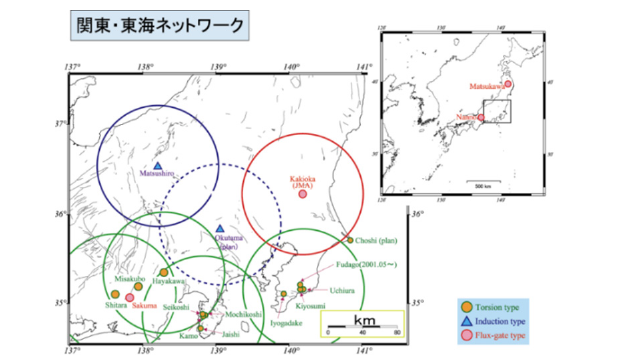
In addition to being affected by the large spacing between geomagnetic station sites, the construction cost of traditional geomagnetic station observation facilities is high, and it is not possible to realize the dense deployment of a large area in the region. According to the requirements for the construction of geomagnetic stations, geomagnetic reference observation requires the construction of absolute observation rooms and relative recording rooms and is equipped with facilities such as comparison kiosks and electrical rooms. At the same time, geomagnetic stations have high requirements for the surrounding electromagnetic environment, cover a large area and protection zone, and are difficult and expensive to acquire land. The current situation of the distribution and construction of the stations mentioned above has seriously restricted the access to a large amount of information on geomagnetic seismic precursor anomalies, which has affected the development of earthquake monitoring and forecasting research. Obtaining geomagnetic field change information with sufficient temporal and spatial resolution in the study area is the basis of earthquake monitoring research. Therefore, it is necessary to build low-cost, easy-to-erect buried geomagnetic station arrays in local areas to capture seismomagnetic anomaly information in a timely manner, to provide more data support and basic information for the realization of short-term prediction of earthquakes. To scientifically design the dense geomagnetic array and seek the optimal solution of construction cost and observation data quality, this paper elaborates on the current status and development trend of geomagnetic array observation technology from the perspective of array observation mode and measurement point observation technology, so as to provide reference for the design of dense geomagnetic observation array.
Array Observation Mode
Fixed measurement points continuous observation
The mode of continuous observation at fixed measurement points is to continuously monitor the local changes of geomagnetic field at fixed points for a long time. At present, the geomagnetic array in the mode of continuous observation of fixed measurement points mainly serves two aspects, one is in earthquake monitoring and forecasting, and the other is in space physics and weather.
Seismic monitoring and forecasting array: The strength of geomagnetic anomaly signals that can be captured before an earthquake is related to the distance from the epicenter and the magnitude of the earthquake. Under a certain earthquake magnitude, the closer the geomagnetic observation point is to the epicenter, the more likely it is to observe and record geomagnetic anomalies. Therefore, geomagnetic stations serving earthquake monitoring and forecasting are generally located in key seismic surveillance zones or seismic hazard zones and are relatively densely packed with measurement points. Between April 1997 and March 2002, Japan implemented a geomagnetic monitoring project (Table 1) consisting of a station array and multiple fluxgate stations. The station array observation instruments include a torsion magnetometer, an induction magnetometer and a fluxgate magnetometer. During the project, the station array observed seismic EM ULF wave anomalies prior to four earthquakes and one earthquake swarm [7]. Based on the evenly distributed geomagnetic stations with a spacing of about 140km, Japan has deployed a small-caliber, high-density geomagnetic station array in the western part of the Izu Peninsula and in the southern part of the Chiba Peninsula. The small-caliber array consists of three sub-stations with a spacing of about 4 to 7km (Figure 2). The observation instruments of the array also fluxgate magnetometer, torsion magnetometer and induction magnetometer. Based on the plane-wave diffusion equation, the seismic case analysis of the Izu Islands earthquake cluster between June 2000 and September 2000 was carried out using the station array observation data. The analysis results show that the pointing directions of the gradient vectors of the two sets of table arrays intersect in the active area of the cluster, and the location of the source of the 2000Izu Islands cluster was determined 2 to 3 weeks before the earthquake [8,9].
Table 1:Comparison of the Tenth Five-Year Precursor arrays and the Izu and Chiba Peninsula arrays.

Figure 2:Dense geomagnetic array in Izu and Chiba Peninsulas, Japan.
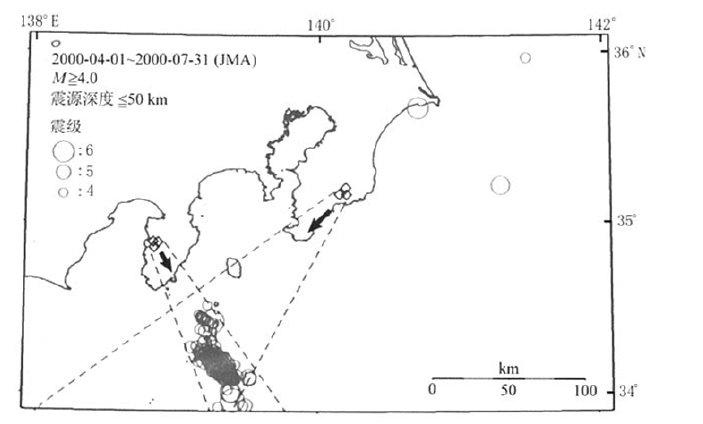
China has started the observation and research of geomagnetic arrays since 2007, and has built several fixed arrays in Xichang, Sichuan, Tianzhu, Gansu, and the Three Gorges Reservoir area in Chongqing. The Xichang array in Sichuan and Tianzhu array in Gansu, which are part of the Tenth Five-Year Precursor Array of the China Earthquake Administration (CEA), are taken as examples. The two arrays were completed in 2007 and are still in the observation period. The observation instruments are all fluxgate sensors. Compared with the geomagnetic arrays in Izu and Chiba Peninsula in Japan, the average spacing of the Tenth Five-Year Precursor geomagnetic arrays is relatively small, but the observing instruments are relatively single, and the sampling rate and accuracy are relatively low (Table 1) [10]. In addition to a single geomagnetic observatory array, the Parkfield Earthquake Prediction Experimental Site on the San Andre Fault in the United States is the most highly regarded integrated seismic array in the world [11]. This array includes magnetometers, magnetotellutics, strain meters, and pore pressure gauges (Figure 3). Since 1976, a geomagnetic station array consisting of seven proton magnetometers has been deployed in the Parkfield area along a closed creep transition zone about 60km long on the San Andres fault. On September 28, 2004, a Ms 6.0 earthquake occurred within the observation area of the array. This earthquake produced coseismic magnetic field changes of 0.2~0.5nT in the data from five measurement points in the array. Based on the inversion of strain, displacement and seismic data within the integrated array, it was possible to obtain magnetic field perturbation variations consistent with the geomagnetic array observations [12].
Figure 3:Parkfield earthquake prediction laboratory station array, USA.

Space physics research chains: The intensity of solar activity directly affects the Earth’s changing magnetic field. When a space event occurs, energetic particles and waves travel from the magnetotail along the magnetic lines of force into the polar regions and then from the polar regions along the magnetic lines of force into the middle and lower latitudes. The pattern of magnetic field variations recorded at geomagnetic sites at different longitudes is also related to the relative position of the Sun and the Earth. Therefore, unlike seismic monitoring and research arrays, which are located quasi-uniformly in key seismic surveillance areas, geomagnetic arrays for space physics research are generally located in chains. Kyushu University, Japan, in conjunction with about 30 international organizations around the world, has established the MAGDAS/CPMN observation network [13], which is mainly a 210° meridian chain and equatorial observation network (Figure 4). The network contains a total of 54 measurement sites, including a geomagnetic observing system of more than 30 geomagnetic basic stations, and observational instruments including fluxgate magnetometers and overhauser magnetometers. It carries out monitoring and research on global auroral activity and energy and plasma transport processes.
Figure 4:MAGDAS/CPMN observation Network.
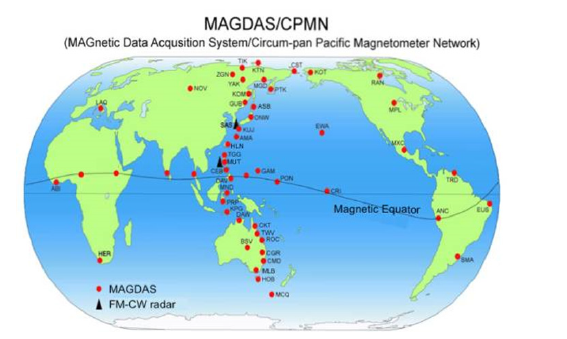
The United States, led by Canada and Japan, has established the Mid-Continent Geomagnetic Field Monitoring Chain (Figure 5), or McMAC station chain, to detect the magnetospheric plasma density distribution. The station chain contains nine measurement points, and the main observation instrument is the UCLA-MAG fluxgate magnetometer. The South American Meridian Monitoring of the Geomagnetic Field (SAMBA) chain has established an observing system of 12 geomagnetic base stations to study the energy transport processes of geomagnetic field disturbances at high and low-middle latitudes. The Canadian Geospatial Monitoring Program (CGMP) has constructed 25 geomagnetic base stations to monitor perturbations of the geomagnetic field by near-Earth space activities. In Denmark, 18 geomagnetic base stations have been deployed along the 300° longitude chain for space science research. To carry out space environment research and realize basic multi-parameter space environment monitoring capability over China, China has implemented the Meridian Project. A total of 31 comprehensive stations, including 27 stations in the geomagnetic meridian chain, have been built along 110° and 120° east longitude and 30° and 40° north latitude. The distance between the stations in the geomagnetic meridian chain is about 800km, and the observation instruments include fluxgate magnetometers, Overhause magnetometers and induction magnetometers. The Meridian Project continuously monitors the space electromagnetic environment through a variety of detection means, providing the basis for scientific observation for the study of the pattern of change of catastrophic weather in space and space weather forecasting. Synthesizing the status of the above studies, a representative comparison of geomagnetic table chain parameters for space physics studies is shown in Table 2.
Figure 5:US McMAC Chain..
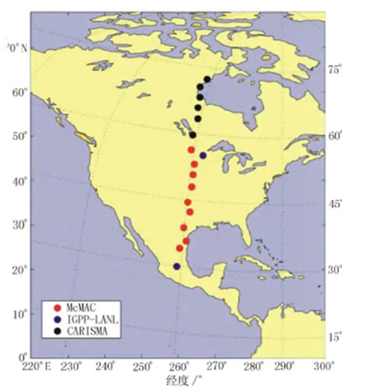
Table 2:Comparison of space physics research chains.

Fixed measurement points periodic re-measurement observation
The mode of periodic re-measurement of fixed measuring points is also called mobile geomagnetic measuring point observation. As a powerful complement to the fixed geomagnetic station network, high-density magnetometer deployment is carried out in the monitoring area to reflect the changes of local geomagnetic field and to study the spatial and temporal changes of local geomagnetic field before and after earthquakes [14-18]. Unlike the geomagnetic field elements observed in the continuous observation mode of fixed measurement points, the periodic remeasurement mode of fixed measurement points mostly monitors the total geomagnetic field strength in localized areas. Based on the geomagnetic reference network, absolute measurements of the geomagnetic field are carried out periodically to study the spatial and temporal distribution of the geomagnetic field in the lithosphere of the monitored area and to capture the information of seismomagnetic anomalies [19]. At present, there are about 1,385 geomagnetic mobile measurement points in China, with an average distance of about 70km between measurement points in the central and eastern regions and an average distance of about 150-200km between measurement points in western regions such as Xinjiang and Tibet.
The Hebei Provincial Seismological Bureau began monitoring a network of mobile geomagnetic stations in the region in 1973. There are two existing networks of regional monitoring stations: the North China Ring and the JiYu Ring (Figure 6). The North China Ring consists of 14 stations in Shijiazhuang, Tangshan, Beijing, and Zhangjiakou, and the observation area contains the Taihang Fracture and the Yanshan-Cangdong Fracture. The network is remeasured four times a year, and mainly monitors seismic activity in the Beijing-Tianjin-Tangshan area, which is a key surveillance area. The Jiyu Ring includes 14 stations in Handan, Anyang, Xingtai, Shixian, etc., and the observation area contains the Magxian, Daiming, Zishan-Gushan ruptures, etc. The network is re-measured twice a year. The network is re-measured twice a year. The instrumentation of both the North China Ring and the JiYu Ring is the G856 proton spinning magnetometer.
Figure 6:Mobile geomagnetic array network in Hebei province.
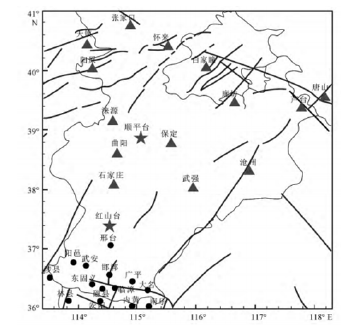
The Physical Exploration Center of the China Earthquake Administration (CEA) has deployed a 37-site mobile geomagnetic survey network (Figure 7) in the Ji-Lu-Yu junction area to study the relationship between seismicity and the geomagnetic field in the region. The mobile network is re-measured four times a year. The observation instrument is a GSM-19T proton rotary magnetometer [20].
Figure 7:Mobile geomagnetic network in the Ji-Lu-Yu junction area.
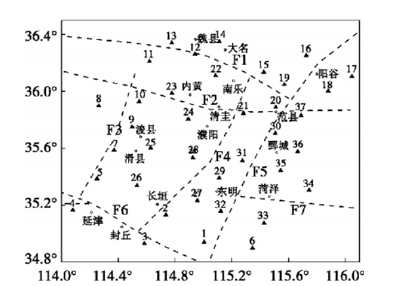
Measuring Point Observation Technology
Due to the geomagnetic instruments are susceptible to external electromagnetic environment interference, as well as temperature changes, changes in the stability of the observation pier and other impacts, it is generally necessary to build a specialized observation room to ensure the reliability of the observation data. For the measurement point with fluxgates, measurement point observation technology can be divided into two categories: strict magnetic room type observation and simple buried observation.
Strict magnetic room type observation
Geomagnetic reference stations continuously monitor the geomagnetic field and its long-term changes in the region. Therefore, for the geomagnetic station construction requirements are high, the basic requirements of the observation site and the surrounding magnetic field distribution is uniform, the total intensity of the geomagnetic field horizontal gradient is required to be within 1nT/m, and the construction materials are all nonmagnetic materials [21]. The relative recording room where the observation instruments are placed should be constructed with at least two recording piers. Meanwhile, the temperature and humidity of the relative recording room have strict requirements. It is generally required that the daily temperature difference is within 0.3 °C, the annual temperature difference is within 10 °C, and the indoor relative humidity is within 85% [22]. Therefore, for strict magnetic room type observation, generally use the basement or semi-basement magnetic room observation method to ensure that the observation room temperature remains stable.
Take the Urumqi geomagnetic reference station (Figure 8) as an example. The relative recording room is designed as an underground arch structure with an arch height of about 1m. The whole structure is made of copper-reinforced concrete, and the internal space is about 2.7m high, covered with a 2m thick layer of loess for insulation. There is a canal of about 15m long between the underground relative record room and the electrical room on the ground. The canal is connected to the stairwell. Within the relative recording room, there are 4 recording piers. The center distance between two piers is 3m, and the distance to the wall is 1.5m. Analog circuit devices are placed 3m away from the recording piers. The ground electrical room is located more than 15m away from the recording piers. The host box is placed in the electrical room and is equipped with AC and DC power supply system, lightning protection system and communication system. Although the strict magnetic room type observation produces high quality data and good observation results, it is too expensive to build, requires high construction and covers a large area. For geomagnetic station arrays with many measurement points, this observation technology scheme is not feasible.
Figure 8:Urumqi geomagnetic reference station.

Simple buried observation
Compared with the complicated and expensive geomagnetic station observation technology, simple buried observation has been gradually popularized in the construction of geomagnetic measurement points due to its simple structure, convenient construction and low cost. There are mainly three types of simple buried geomagnetic observation technology programs: pit-type, L-type cross-pipe buried and straight tube buried.
China’s Tenth Five-Year precursor Xichang geomagnetic station array adopts the pit-type buried construction. The pit of the fluxgate probe room is 2.1m deep, and a 1m long marble pier is buried deep in the pit. The fluxgate sensor is placed on the marble pier, about 1.1m from the surface. After completing the orientation of the sensor, the sensor is covered with a center cover and an outer cover and the inter-cover is filled with polystyrene foam. The top of the pit is covered with a 0.8m layer of soil to provide thermal insulation. The host room is 3~5m away from the probe room. Long-term operation results show that the pit-type buried observation output data continuity rate is 97%, the daily temperature difference is within 0.3 ℃, and the observation status is good [23]. However, it adopts the form of instrumental closed observation, and the maintenance work is difficult.
The Datong Geomagnetic Observatory in Shanxi Province adopts the method of burying FRP L-type horizontal pipes for geomagnetic observation. The main body of the observatory is a 10-meter-long, 2.8-meter-diameter-diameter-diameter FRP pipe, which is buried in a deep pit 4 meters below the ground surface (Figure 9). There are three piers in the deep pit and the fiberglass cross tubes are sleeved over the piers. To make the temperature difference in the observation room to achieve the relative recording room observation needs, the cross tube is covered with a 1m thick thermal insulation board and covered with a 1m thick layer of soil for heat preservation. Although the construction cost of the L-shaped cross-pipe buried observation is reduced relative to the strict magnetic room observation, the L-shaped construction work is large and complex and is not suitable for dense geomagnetic observatory arrays. Gansu Province designed a simple and maintainable straight-type geomagnetic observation and recording chamber for the buried geomagnetic observation technology. Two observation pits with a spacing of 2m and a depth of 2.5m are dug in the ground. The pits are each long with 0.8m diameter bellows, and the top of the bellows exceed the ground surface by 0.5m. The bottom surface of the pit is paved with a stone layer and a concrete layer. The observation pier is placed on the concrete surface at the bottom end of the bellows, and the surface of the observation pier is coated with acrylic waterproof coating. The geomagnetic instrument is placed in the center of the top of the observation pier, and the two geomagnetic instruments in the bellows are connected by a signal cable, which is placed inside a PVC pipe. The top of the bellows is equipped with a moving cover plate, and the inside is equipped with a protective net, which can effectively prevent debris and other debris from entering the bellows and improve the protection function of the geomagnetic instruments.
Figure 9:L-shaped cross-pipe buried observation in Datong, Shanxi.
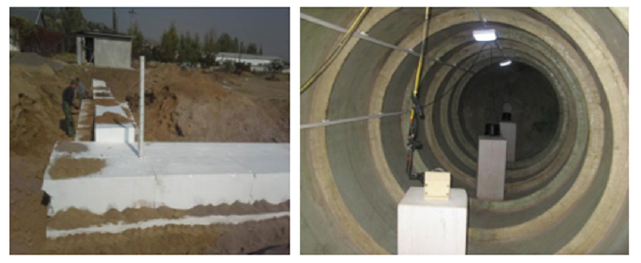
Figure 10:Straight cylinder type buried observation technology.

The overall observation technology program is shown in Figure 10, where 1 is a moving cover, 2 is a protective net, 3 is an observation pit, 4 is a corrugated pipe, 5 is a PVC pipe, 6 is a pipe support seat, 7 is a bump, 8 is a baffle plate, 9 is an observation pier, 10 is a concrete layer, 11 is a gravel layer, 12 is a signal line, 13 is a geomagnetic instrument, 14 is a double-heading stud, 15 is a ground surface, 16 is a waterproofing layer, 17 is a fixing plate, 18 is a fixing rod and 19 is a supporting rod. It solves the problems of instrument damage and high maintenance cost caused by underground humidity and can meet the requirements of long-term geomagnetic observation. The geomagnetic observation station in Machu, Gansu, has constructed a geomagnetic observation measurement point (Figure 11) by using the above mentioned straight-type buried observation technique. The instrument recording pier is constructed directly in a 3m pit, and a corrugated pipe with a diameter of 0.8m and a length of 3m covers the instrument pier. Polystyrene foam is used to fill the tube, and the soil layer is covered with fiberglass plate to insulate the observation chamber after sealing the tube opening. The straight tube type buried observation technology is inexpensive and easy to construct, which is of reference significance for the design of dense geomagnetic observatory array.
Figure 11:Straight cylinder type buried observation in Machu, Gansu Province.
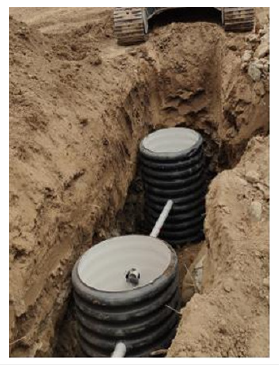
Considering the three simple buried observation technology, the straight and L-shaped cross-pipe buried observations are easier to control the temperature of the observation chamber than the pit-type buried observations, and the straight type has a smaller construction volume than the L-shaped cross-pipe buried technology, with lower construction costs and a smaller footprint. In summary, compared with the above point observation technology, the simple buried point observation technology has a smaller footprint and is more convenient than the strict magnetic room point observation technology, and it is more suitable for the construction of dense geomagnetic observation station arrays with many densely distributed points. Among them, the straight type buried measuring point observation technology has good observation effect at present.
Discussion and Conclusion
In this paper, the development status of geomagnetic array is introduced from two aspects, namely, the observation mode of array and the observation technology of measurement points. The two main observation modes of fixed-point continuous observation and fixed-point periodic re-measurement are described, including the station array for seismic monitoring and forecasting research, the station chain for space physics research and the mobile geomagnetic network for monitoring the local geomagnetic total field strength. The implementation schemes of the strict magnetic room type measuring point observation technology and the simple buried-type measuring point observation technology are analyzed. Buried measurement point observation technologies such as pittype, straight tube, L-shaped cross tube, and their advantages and disadvantages are described in detail. This paper analyzes the observation mode and observation technology of the geomagnetic observation array, which provides reference for the design and implementation of the dense geomagnetic observation station array.
Acknowledgement
This research was funded by a research start-up grant from Suzhou Vocational Institute of Industrial Technology (SIIT), grant number 2023kyqd007.
References
- Zhou Jinping (1999) Advances of geomagnetic network observation and research in China. Seismological and Geomagnetic Observation and Research 20(5): 113-120.
- Gu Chunlei, Zhang Yi, Gu Zuowen, Wang Xingzhou, Wang Lei, et al. (2012) Relationship between zero-value-line of abnormal geomagnetic field in lithosphere and strong-moderate earthquake epicenters in north China seismic region. Northwestern Seismological Journal 34(2): 174-179.
- Song Chengke (2021) Geomagnetic anomalies prior to the Jiuzhaigou Ms7.0 earthquake in 2017. China Earthquake Engineering Journal 43(5): 1037-1044.
- Li Qi, Yang Xing, Cai Shaoping (2015) Case study of applying polarization method to geomagnetic array data. Technology for Earthquake Disaster Prevention 10(2): 412-417.
- Li Qi, Zhu Peiyu, Mamatemin Alimjan, Xu Xuegong (2011) Detection of ULF electromagnetic emissions as a precursor to two earthquakes in China. Earthquake Science 24(6): 601-607.
- Yao Yuan, Li Qi, Yao Xiuyi, Xu Jin, Wang Jianjun (2018) Anomalies of ULF magnetic field variations prior to the Jinggu Ms6.6 earthquake. North China Earthquake Sciences 36(4): 49-54.
- Hayakawa M (2004) Electromagnetic phenomena associated with earthquakes: A frontier in terrestrial electromagnetic noise environment. Recent Res Devel Geophysics 6: 81-112.
- Hayakawa M, Hattori K, Ohta K (2007) Monitoring of ULF (Ultra-Low-Frequency) geomagnetic variations associated with earthquakes. Sensors 7(7): 1108-1122.
- Li Qi, Li Junran, Yang Dongmei, Chen Huaran (2008) The state of the art in the study of ULF geomagnetic variations associated with earthquakes. Seismological and Geomagnetic Observation and Research 29(6): 170-176.
- Li Qi (2007) Investigation of geomagnetic observatory networks both at home and abroad. Recent Developments in World Seismology 345(9): 20-28.
- Zhang Guomin, Niu Fenglin, Shao Zhigang (2009) The Parkfield earthquake prediction experiment: 2004 M6.0 earthquake and its impact on the earthquake physics and earthquake prediction study. Earthquake Research in China 25(4): 345-355.
- Johnston MJS, Sasai Y, Egbert GD, Mueller RJ (2006) Seismomagntic effects from the long-awaited 28 September 2004 M6.0 Prakfield earthquake. Translated World Seismology 96(6): 14-31.
- Umar R, Natasha SF, Aminah SSN, Juhari KN, Jusoh MH, et al. (2019) Magnetic Data Acquisition System (MAGDAS) Malaysia: installation and preliminary data analysis at ESERI, UNISZA. Indian Journal of Physics 93: 553–564.
- Li Hua, Huang Lijing, Xu Yixi (2007) Analysis on the anomalies in mobile geomagnetic survey before Shunchang M4.9,4.7 earthquakes on March13, 2007 in Fujian province. Northwestern Seismological Journal 29(3): 267-270.
- Xu Yixi, Fang Wei, Chen Xinze, Zhang Yonggu, Zhou Changxian, et al. (2010) Analysis on the results of mobile geomagnetic survey before Changtai ML4.7 earthquake in Fujian province on July 5, 2008. Seismological and Geomagnetic Observation and Research 31(1): 39-42.
- Yan Suping, Yuan Jiehao, Gu Chunlei, Chen Bin, Xu Rugang, et al. (2011) Study on practical technology of movable fluxgate array monitoring. Recent Developments in World Seismology 387(3): 9.
- Jin Yuzhen, Lin Mujin, Fan Xiaoyu, Liu Xiaoping, He Jia, et al. (2015) Relationship between anomalies of mobile geomagnetic observation and moderately strong earthquakes in Shanxi. Earthquake Research in Shanxi 163(3): 1-6.
- Cui Zeyan, Zhang Xiao, Wang Hui, Liu Jing, Li Jin, et al. (2018) Anomaly characteristics of mobile geomagnetic observation in Hebei province. China Earthquake Engineering Journal 40(2): 329-334.
- Su Shupeng (2010) Determination of reference value for abnormal information extraction in mobile geomagnetic survey. Journal of Geodesy and Geodynamics 30(S1): 44-49.
- Xu Zhiping, Xu Shunqiang, Jiang Lei, Li Deiqing, Kang Min, et al. (2017) Anomaly variation of mobile geomagnetic total intensity and seismicity analysis in juncture area of Hei, Shangdong and Henan. Earthquake Research in Shanxi 171(3): 28-33.
- Zhang Yingjie, Zhang Xiaotao, Zhao Changhong, Jiang Yongjian, Li Xiaopeng (2017) Construction of observation room at Shexian geomagnetic station. Seismological and Geomagnetic Observation and Research 38(3): 100-106.
- Zhang Liange, Yan Jiming, Chen Changjun, Wang Xinsheng, Wei Jinlong (2008) Quality control in the construction of geomagnetic relatively observation room in Taiyuan seismic station. Seismological and Geomagnetic Observation and Research 29(6): 71-75.
- Du Bin, An Mingzhi, Lin Yang, Lu Ting, Yuan Yanni, et al. (2008) Implementing scheme for installing fluxgate magnetometers in the field. Seismological and Geomagnetic Observation and Research 29(6): 154-160.
 a Creative Commons Attribution 4.0 International License. Based on a work at www.crimsonpublishers.com.
Best viewed in
a Creative Commons Attribution 4.0 International License. Based on a work at www.crimsonpublishers.com.
Best viewed in 







.jpg)






























 Editorial Board Registrations
Editorial Board Registrations Submit your Article
Submit your Article Refer a Friend
Refer a Friend Advertise With Us
Advertise With Us
.jpg)






.jpg)














.bmp)
.jpg)
.png)
.jpg)










.jpg)






.png)

.png)



.png)






